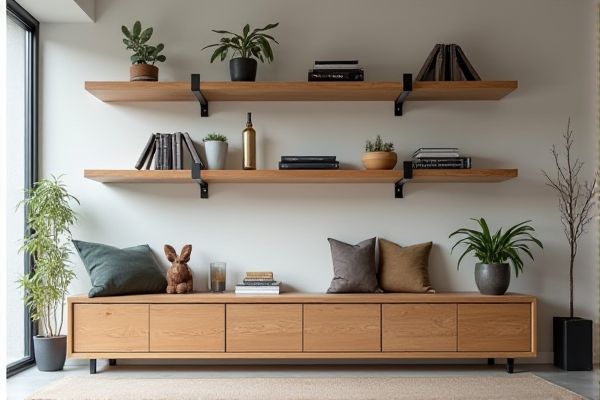
Cantilever shelving offers superior flexibility for storing long or bulky items without obstruction, while bracket shelving provides sturdy support ideal for everyday organization and heavier loads. Discover which shelving option best suits Your storage needs by exploring the detailed comparison in the rest of this article.
Table of Comparison
| Feature | Cantilever Shelving | Bracket Shelving |
|---|---|---|
| Design | Single vertical column with horizontal arms | Wall-mounted brackets supporting shelves |
| Load Capacity | High load capacity, ideal for heavy items | Moderate load capacity, best for lighter items |
| Installation | Freestanding, no wall required | Requires secure wall attachment |
| Flexibility | Adjustable arms, good for long or bulky items | Shelf height adjustable, limited by bracket size |
| Space Efficiency | Access from one side, takes more floor space | Uses wall space, saves floor area |
| Typical Uses | Storing lumber, pipes, heavy tools | Holding books, decor, small storage boxes |
| Cost | Generally higher due to robust design | More affordable and easier to install |
Introduction to Cantilever Shelving and Bracket Shelving
Cantilever shelving features open-ended arms that support long, bulky items like lumber or pipes, making it ideal for warehouses and industrial storage. Bracket shelving consists of a horizontal shelf supported by wall-mounted brackets, suited for lightweight to medium-weight loads in offices or retail spaces. You can choose cantilever shelving for heavy-duty storage needs or bracket shelving for versatile, space-saving organization.
Structural Design Differences
Cantilever shelving features horizontal arms extending from a single vertical column, allowing for easy storage of long or bulky items without front supports, which maximizes accessibility and storage flexibility. Bracket shelving employs horizontal brackets mounted between two vertical supports, providing stable, evenly distributed weight capacity ideal for lighter or uniformly shaped items. Your choice between these shelving types should consider the structural requirements of your storage needs, with cantilever systems excelling in accommodating heavy, awkward loads and bracket systems suited for standard organizational tasks.
Load Capacity and Weight Distribution
Cantilever shelving offers superior load capacity and even weight distribution by using horizontal arms that extend without front supports, making it ideal for heavy or bulky items. Bracket shelving relies on fixed brackets attached to walls, which limits weight capacity and can cause uneven load distribution if improperly installed. Your choice should consider the specific weight demands and stability needed for efficient storage management.
Installation Requirements
Cantilever shelving requires minimal wall support and is ideal for storing long or bulky items, with its vertical posts fixed to the floor for stability. Bracket shelving depends on secure wall mounting with brackets spaced according to load requirements, making wall integrity crucial for proper installation. You should assess your space's structural support before choosing between the flexible floor-mounted cantilever system or the wall-dependent bracket shelving.
Space Utilization and Flexibility
Cantilever shelving maximizes space utilization by offering open-front access and adjustable arms that accommodate varying shelf lengths and heights, ideal for storing long or bulky items. Bracket shelving provides flexibility through easily movable shelf supports that allow you to customize shelf spacing and configuration to fit different storage needs. Your choice depends on whether you prioritize heavy-duty load capacity with cantilever shelves or adaptable, modular setups with bracket shelving.
Material Types and Durability
Cantilever shelving typically utilizes heavy-duty steel or aluminum materials, providing exceptional durability for storing long or bulky items, particularly in industrial settings. Bracket shelving often employs a combination of metal brackets and wood or composite shelves, offering moderate strength suited for lighter loads in residential or office environments. Steel cantilever arms provide superior load-bearing capacity and resistance to deformation, while bracket shelving materials may show wear faster under heavy or uneven weight distribution.
Cost Comparison
Cantilever shelving generally incurs higher initial costs compared to bracket shelving due to its heavy-duty construction and design for supporting longer, bulkier items. Bracket shelving offers a more budget-friendly option with simpler installation and lower material costs, making it ideal for lighter loads and smaller spaces. Long-term investment should consider maintenance and durability, where cantilever shelves may provide better value in industrial or high-capacity environments despite the upfront expense.
Ideal Applications for Cantilever Shelving
Cantilever shelving excels in storing long, bulky items such as lumber, pipes, and steel bars, making it ideal for warehouses, lumberyards, and manufacturing facilities. Its open-ended design allows easy loading and unloading of irregularly shaped goods, optimizing space for heavy-duty storage needs. Your facility can benefit from enhanced accessibility and efficient organization when using cantilever shelving for oversized materials.
Ideal Applications for Bracket Shelving
Bracket shelving is ideal for lightweight to medium-duty storage needs, making it perfect for organizing books, decorative items, kitchenware, or office supplies. Its versatility supports various wall types and provides easy installation, allowing you to efficiently maximize space in living rooms, kitchens, or workspaces. Compared to cantilever shelving, bracket shelving is better suited for smaller, everyday items rather than heavy or bulky loads.
Choosing the Right Shelving Solution for Your Needs
Cantilever shelving offers superior flexibility for storing long, bulky items like lumber or pipes, making it ideal for warehouses and industrial spaces. Bracket shelving provides sturdy support for heavier loads and is versatile for use in retail, office, or residential settings where adjustable shelving is beneficial. Evaluating the type of items, load capacity, and space constraints ensures the selection of the optimal shelving solution for efficient storage and accessibility.
 homyna.com
homyna.com